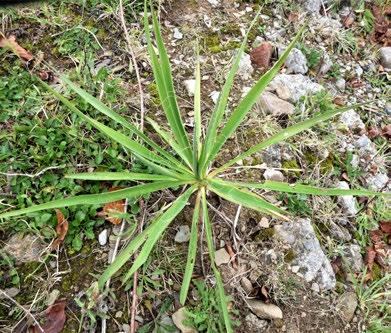
18 minute read
Compiled by Matthew Berry
ADVENTIVES AND ALIENS
Adventives and Aliens News 23
Advertisement
Compiled by Matthew Berry
Flat 2, Lascelles Mansions, 8–10 Lascelles Terrace, Eastbourne BN21 4BJ
m.berry15100@btinternet.com
The generosity of contributors requires me to keep this introduction as short as I can, so that as much of the botanical interest as possible can be shared. Suffice it to say that, where feasible, remarks that might have gone into the preamble have been integrated into the record entries themselves, if in a compressed form. Many thanks.
V.c.3 (S. Devon)
Pelargonium peltatum (L.) L’ Hér. ex Aiton (Ivy-leaved Geranium). Plymouth (SX47595377), 14/8/2020, P. Pullen: growing on a limestone cliff amongst ivy and brambles. A trailing or climbing perennial (Geraniaceae) with somewhat fleshy leaves and very variable with respect to flower colour and markings. A native of S. Africa. The determination is somewhat provisional and the plant could be a hybrid (P. Pullen pers. comm.).
Salvia hispanica L. (Chia). Exeter Quay (SX919921), 28/11/2020, R. Hodgson: several flowering plants growing at quay side. The first Devon record. It is almost certainly being under-recorded in the nonflowering stages. The DDb now contains 11 other records divided between v.cc.6, 12, 23, 29, 39 and 40. See Adventives & Aliens News 14 for more details of the Chew Valley Lake (v.c.6) record. It has also been reported in v.cc.14 and 44 (M. Berry, 2019).
Yucca filamentosa L. (Adam’s-needle). Plymouth (SX4960359662), 28/9/2020, P. Pullen (conf. J. Poland): four plants growing close together on disturbed ground at Derriford Hospital. An evergreen garden shrub (Asparagaceae), native to the south-eastern US. The trunk is absent or prostrate (vs erect in Y. gloriosa [Spanish-dagger]). The leaves soon split into fine filaments particularly towards the tips, thus the specific epithet. See Poland & Clement (2020), p. 112.
Yucca filamentosa, Plymouth, South Devon (v.c. 3). Phil Pullen
V.c.4 (N. Devon)
Mirabilis jalapa (Marvel-of-Peru). Bideford (SS46022623), 13/11/2020, R.I. Kirby: one plant growing on pavement at base of high south-facing retaining wall, Torrington Lane, East-the-Water. The first Devon record. A perennial garden plant (Nyctaginaceae), native to tropical America. It seems to set good seed. Of the two principal colour forms, red- and yellow-flowered, the red seems by far the most common. It is the only (‘wild’) British representative of the family, which includes the Bougainvilleas. Clement et al. (2005): 38. Stace (2019): 537.
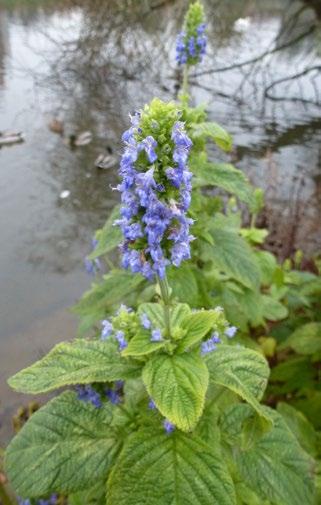
Salvia hispanica, Exeter Quay, South Devon (v.c. 3). Bob Hodgson
V.c.9 (Dorset)
Scabiosa ochroleuca L. (Yellow Scabious). Swanage (SZ0299078595), 2/8/2020, D. Leadbetter: one plant escaped from sown area, west end of Manor Road. A garden biennial (Dipsacaceae) with yellow or cream corollas, a native of central and southeastern Europe. It is sometimes treated at varietal rank, i.e. Scabiosa columbaria L. var. ochroleuca (L.) Coulter. There are six records in the DDb, all but one of them post-2000.
V.c.10 (Isle of Wight)
Silene dichotoma (Forked Catchfly). Bowcombe area (SZ461863), 11/2020, P. Stanley & M. Larter: 15 plants in game cover (Fennel) on chalk, Idlecombe Farm; Shorwell area (SZ468834), 22/11/2020, P. Stanley & M. Larter: 35 plants in game cover of Fennel on chalk, New Barn Farm. The last v.c.10 record was for 1965 (Bill Shepard). There are four post-2000 records in the DDb, for v.cc.1 (2017), 8 (2020), 18 (2019) and 113 (2000–2009). A Eurasian annual (Caryophyllaceae) which once occurred in wheat fields, presumably when the grain was imported from places where S. dichotoma is/was a frequent weed, e.g. south-eastern Europe and Turkey. It is also listed as a bird-seed and wool alien. The epithet ‘dichotoma’ refers to the forking inflorescence (often with solitary alar flowers in the forks). Clement et al. (2005): 74. Stace (2019): 503.
Centaurea intybacea Lam. (False Chicory-knapweed). West of Newport (SZ461891), 10/2020, P. Stanley & M. Larter: one plant in extensive crop of Trifolium alexandrinum (Egyptian Clover), Betty Haunt Lane. There are no records in the DDb and this might be the first post-1930 record for Britain and Ireland. A native of south-western Europe (France and Spain), where one of its habitats is broken rocky ground by the sea. Online images show a glabrous, variably branched or even unbranched composite. The capitula, with plumes of pinkish-purple ligulate florets, occur singly on long peduncles; the rounded involucre with shiny, tightly appressed phyllaries, each oblong-ovate in outline and with a row of yellowish-white apical teeth. The upper cauline leaves are linear and more or less entire, the lower and mid cauline leaves deeply pinnately lobed. The stem becomes woody at the base but it might behave as an annual in this country. It is 40–100cm tall. According to some authorities, it rightly belongs in the genus Cheirolophus. Of the weeds found as impurities of these various clover crops (see Adventives & Aliens News 19 and 21, v.c.10), this species is the odd one out, the others overwhelmingly originating in the Mediterranean/E. Mediterranean and/or south-west Asia. It should be looked for in clover crops elsewhere.
Centaurea solstitialis (Yellow Star-thistle). Brook (SZ384839), 10/2020, P. Stanley & M. Larter: two plants by side of dung heap with sown Lucerne in close proximity. Plants were also seen at this site by Robin Lang (8/2020). The last v.c.10 record was for 1932 (Gladys Bullock). See v.c.15.
V.c.11 (S. Hants)
Tagetes minuta (Southern Marigold). Chandler’s Ford (SU437212), 26/10/2020, M. Rand: several plants in suburban road gutter, Carlyn Drive. The first v.c. record since 1961. An annual composite native to S. America. There are recent records from 1997 as a relic wool alien at Flitwick (v.c.30) and from 2019 for Dowlais (v.c.41). As well as wool, it is listed as a cotton and bird-seed casual, Clement & Foster (1994). Clement et al.(2005): 362. Stace (2019): 820.
V.c.12 (N. Hants)
Scilla bifolia (Alpine Squill). Winchester (SU49042925), 7/3/2020, A. Stewart (comm. A. Mundell): under Lime tree on grass verge, spreading or surviving from planted, Northbrook Avenue. A bulbous garden perennial (Asparagaceae), native to Europe and south-west Asia. Stace (2019): 965.
V.c.13 (W. Sussex)
Paulownia tomentosa (Foxglove Tree). Bognor Regis (SZ9399), 13/5/2020, M. Shaw (det. M. Berry): base of wall in railway station car park. There was no parent tree obviously present nearby. The first v.c. record. A deciduous ornamental tree (Paulowniaceae), native to China. Self-sown plants are increasing, probably with warming climate. Stace (2019): 680.
V.c.14 (E. Sussex)
Hyssopus officinalis (Hyssop). Lewes (TQ4225610340), 7/10/2020, P. Harmes (det. M. Berry): one plant in pavement crack outside property, Chapel Hill. The first v.c.14 record. It will be interesting to see if it persists. A loosely tufted, aromatic, evergreen subshrub (Lamiaceae), native to the Mediterranean. It is a somewhat variable species. Stace (2019): 666.
V.c.15 (E. Kent)
Centaurea solstitialis (Yellow Star-thistle). Wye area (TR0614846728), 30/7/2019, D. Chesterman: one plant in field east of Wye, growing where Trifolium pratense (Red Clover) had been sown. Always rare in Kent, this is the first record for some time. See Kent Botany 2019, pp. 11–12. An annual grain, bird-seed, lucerne seed and wool alien (Asteraceae) from the Mediterranean, it is much rarer nationally than it was in former times. It is/was also a serious arable weed in California. See Adventives & Aliens News 19, v.c.10. Stace (2019): 736.
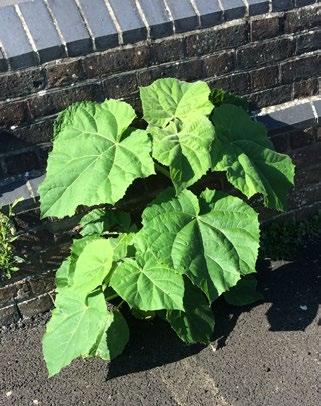
Paulownia tomentosa, Bognor Regis, West Sussex (v.c. 13). Mike Shaw
V.c.19 (N. Essex)
Trifolium pannonicum (Hungarian Clover). Chignall C.P. (TL6811), 12/6/2020, G. Clark (det. K. Adams): in flower on both sides of farm track, Walnut Tree Farm, first seen in 2019; Great Clacton C.P. (TM1917), 18/8/2019, Tendring Wild Flower Group (det. K. Adams): patch in flower, track by arable field, Sladbury’s Farm; Little Clacton C.P. (TM1919), 18/8/2019, TWFG (det. K. Adams): patch on track by arable field, west of Great Holland Pits. A southern European annual (Fabaceae) known in Britain and Ireland as a possible fodder and definite ballast alien, as well as a probable introduction with grass seed. It is also a garden plant. See Adventives & Aliens News 17, v.c.H2. Essex Botany No. 11 (Summer 2020), p. 4. Stace (2019): 188.
V.c.21 (Middlesex)
Alyssum montanum L. (Mountain Alison). Orde Hall Street WC1 (TQ30458194), 1/7/2020, J. Edgington (det. E.J. Clement & R.M. Burton): plants covering an area of c. 1m × 0.5m on ground by the north boundary of Tybald’s Estate. John Edgington described the associates as being quite typical for this sort of habitat in Central London. They include Artemisia vulgaris (Mugwort), Ailanthus altissima (Tree-of-heaven), Lipandra polysperma (Many-seeded Goosefoot), Malva sylvestris (Common Mallow) and Mercurialis annua (Annual Mercury). There were indications the area had been planted out in the past but long since neglected. A garden perennial (Brassicaceae) native to Europe. A. alyssoides (Small Alison) is an annual or biennial with paler flowers. A. murale, for which there are historical records for v.cc.8 and 21, has a corymbose inflorescence (a raceme in A. montanum), flowers with entire petals (notched in A. montanum) and leaves greener above than below (white-appressed hairy both sides in A. montanum).
Portulaca oleracea (Common Purslane). Lincoln’s Inn Fields (TQ30758145), 9/9/2020, J. Edgington (det. M. Berry): covering a c. 0.5m × 0.5m area in grassy border adjacent to pavement on north side
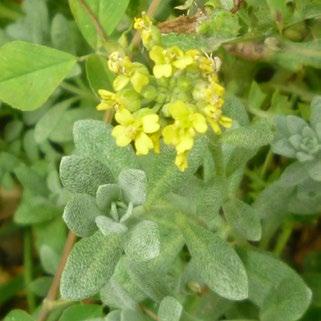
Alyssum montanum, London WC1, Middlesex (v.c. 21). John Edgington of Lincoln’s Inn Fields. A Mediterranean annual (Portulacaceae) with surprisingly few records for Central London. John Edgington measured the seeds at 0.6–0.8mm indicating subsp. oleracea, which would agree with the roughly prostrate, matlike growth. Contemporary records might have a number of different origins with its use as a pot herb and/or health food as well as other miscellaneous sources, at least as important, if not more so, than bird-seed. Clement et al. (2005): 68. Stace (2019): 539. Increasing.
Arthraxon hispidus (Thunb.) Makino (Small Carpetgrass). Ickenham/Uxbridge (TQ0786), 10/10/2020, G. Tranter (det. G. Hanson/comm. M. Spencer): small, non-flowering mat growing alongside Erucastrum abyssinicum and Guizotia abyssinica, under bird feeder in garden. The first county record. An annual, mat-forming grass native to Asia, Australasia and tropical Africa. It is also an invasive alien of the south-eastern US. See Adventives & Aliens News 6, v.c.36.
V.c.27 (E. Norfolk)
Sidalcea malviflora (Greek Mallow). North Walsham and Dilham Canal (TG294317), 10/2020, M. Ghullam (comm. S. Pryce): one plant with very pale pink flowers on ‘shoulder’ of canal embankment (in the Royston Bridge to Swafield section of the canal). Sidalcea are N. American perennials (Malvaceae) with flowers that lack an epicalyx, have linear stigmas and deeply dissected upper stem leaves. Garden plants are probably most often hybrids involving permutations of S. malviflora, S. candida and S. oregana among others, and this plant might well be a hybrid cultivar. Stace (2019): 404.
Calandrinia ciliata (Ruíz & Pav.) DC. (Red-maids). North Walsham and Dilham Canal (TG2931), 14/5/2019, S. Pryce (det. M. Crewe/comm. S. Pryce): one plant of numerous prostrate stems on ‘shoulder’ of canal embankment, a few hundred yards north-west of Royston Bridge. Suki Pryce described the substrate as being typical of that used to build up the embankment, ‘probably fairly freedraining but capable of binding and with some loam fill’. It could not be found in 2020 (S. Pryce
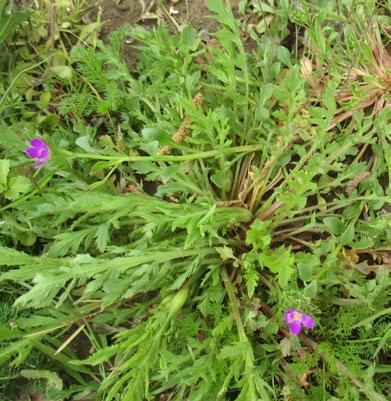
Calandrinia ciliata, North Walsham and Dilham Canal, East Norfolk (v.c. 27). Suki Pryce
pers. comm.). It is an annual, native to western N. America and S. America. The two sepals per flower are typical for Portulacaceae. It is described as a grain and seed alien in this country but there might well be other means of introduction. Apart from a 2020 v.c.1a record, there are no other recent ones but it was once semi-established on cultivated sandy ground in v.cc.3 and 113, Clement & Foster (1994). The S. American C. umbellata has been recorded from v.c.1. It has narrower, more linear leaves and smaller flowers in a congested terminal cyme rather than a lax raceme. The N. American C. breweri has never been claimed for Britain and Ireland. It can only be reliably separated from C. ciliata by certain fruiting characters. The Chilean C. grandiflora is a rarely grown, relatively tall, large-flowered garden plant.
Rubia tinctorum (Madder). Norwich (TG20), 9/2020, R.M. Leaney: several plants in the paved footings of Maddermarket Church. The first Norfolk record. ‘Maddermarket’ indicates a former commercial association between species and place, but Rob Leaney and Jo Parmenter tend to think these plants have a more recent origin, in some way connected with use of the (non-working) church by various local activity groups. An herbaceous perennial (Rubiaceae) native to the eastern Mediterranean and Asia, once widely cultivated as a dye plant – in England especially in the Faversham area of Kent. It is now also a garden plant. BSBI News 74, pp. 1 and 42–44. Stace (2019): 575.
Cotula australis (Annual Buttonweed). North Walsham (TG23), 6/2020, M. Ghullam: over 150 plants in tarmacked pavement, at kerb edge, in gutter and along gravelled driveway. Some of the associates were also notable aliens – Oenothera stricta (Fragrant Evening-primrose), Briza maxima (Greater Quaking-grass), Polypogon viridis (Water Bent) and Erigeron sumatrensis (Guernsey Fleabane). The second Norfolk and East Norfolk record, the other being in the amenity grassland of a caravan and camping site. Adventives & Aliens News 21, v.c.14.
V.c.29 (Cambs)
Eryngium paniculatum Cav. & Dombey ex F. Delaroche (Chupalla). Shepreth (TL392479), 29/3/2019, P.J. Reynolds (comm. J. Shanklin): one plant self-sown in asphalt at base of house wall, Dowcra’s Close. The plant almost certainly originated from the garden of Dowcra’s Manor, where this species has long been in cultivation. The long, linear basal leaves have erectopatent spines at their margins and are up to 5cm wide (usually less). The long, upright, paniculate inflorescences comprise numerous, greenish-white, globular capitula, each equipped with up to ten leathery, spineless bracts. It is a native (Apiaceae) of Brazil, Argentina and Chile, and can attain a height of 2m. See Adventives & Aliens News 20, v.c.83. Another of the S. American Eryngium species whose basal leaf tussocks resemble those of quite unrelated families (e.g. Asparagaceae and Bromeliaceae).
V.c.31 (Hunts)
Beckmannia syzigachne (American Slough-grass). St. Ives (TL30717242), 1/9/2019, N. Millar (conf. & comm. D. Broughton): single plant in gutter on south side of road, Beech Drive. The first v.c. record. It was once a persistent dock alien at Avonmouth (v.c.34)
and has been detected as an impurity of rye-grass seed imported from N. America, Ryves et al (1996). In Belgium it is a regular, recently increasing alien seen mostly in port areas, but sometimes where the means of introduction is not obvious (The Manual of the Alien Plants of Belgium, online). An annual or shortlived perennial grass and a native of N. America and Asia. There are no (?) recent, confirmed records for the very similar (but properly perennial) Eurasian native, B. eruciformis (European Slough-grass). Ryves et al (1996), fig. 17. Stace (2019): 1083.
V.c.35 (Mons)
Lemna turionifera (Red Duckweed). St. Brides Wentlooge (ST300815), 29/7/2020, B. Stewart (comm. S.J. Tyler): present in a reen. There are 11 other v.c.35 records in the DDb. There are otherwise records for the following v.cc: 5, 6, 7, 8, 9, 11, 13, 21, 24, 27, 28, 29, 33, 35, 40, 41, 42, 52, 53, 54, 57 and 83. Quite surprising for a species unknown in this country before 2007 and hard not to conclude that it is being missed elsewhere. A native (Araceae) of N. America and Asia. It is keyed out along with the American species L. valdiviana (Valdivia Duckweed) on p. 60 of Poland & Clement (2020). Stace (2019): 876.
V.c.40 (Salop)
Nemesia denticulata (Toothed Aloha). Ludlow (SO512743), 24/8/2019, A. Woods: in pavement of Lower Broad Street. A S. African perennial (Scrophulariaceae) which is particularly a feature of planters and hanging baskets and can readily self-sow from them. Stace (2019): 644.
V.c.42 (Brecs)
Borago pygmaea (Slender Borage). Llandbedr (SO236203), 21/10/2020, M. Biss (comm. S.J. Tyler): on rough ground outside a garden, Neuadd Fechan. It seems to be the first v.c. record. A perennial garden plant (Boraginaceae), native to Corsica and Sardinia. It was originally described in a different family, basionym Campanula pygmaea DC. Clement et al. (2005): 234. Stace (2019): 594.
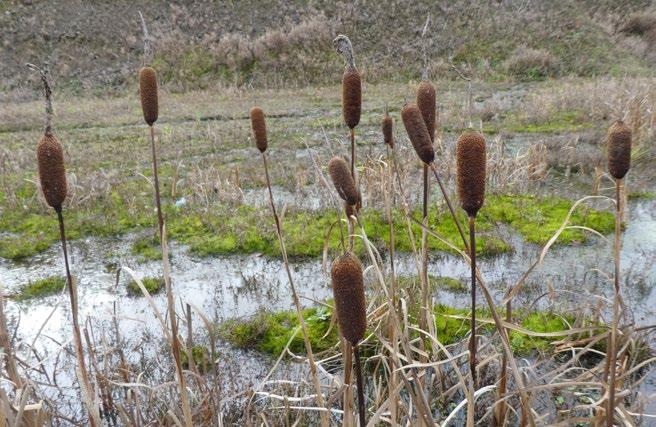
Typha laxmannii, Bamford, Derbyshire (v.c. 57). Mick Lacey
V.c.57 (Derbys)
Typha laxmannii Lepechin (Laxmann’s Bulrush). Bamford (SK2076182287), 16/11/2020, M. Lacey (det. R. Lansdown): established along gravelly ditch in waste ground, the site of derelict Marquis of Granby pub. It appeared to be the dominant reedmace, with just a small clump of T. latifolia (Bulrush) at one end of the ditch. The first v.c. record. A native (Typhaceae) of south-eastern Europe and Asia, planted at the margins of ornamental lakes and ponds etc. It differs from T. minima (Slender Bulrush) (see Stace [2019]: 973) in its wider leaves (up to 7mm but more usually 2–4mm vs 1–3mm), longer female spikes (4–7cm vs 1.5–4cm) separated from the male spikes by an obvious gap (1–6cm vs more or less contiguous) and the absence of bracts. There are three other records in the DDb for v.cc.8, 55 and 64.
V.c.58 (Cheshire)
Alchemilla conjuncta (Silver Lady’s-mantle). Sale (SJ796929), 26/5/2020, G.M. Kay: two plants in willow scrub, Priory Gardens. Graeme Kay emphasises that ‘the site bears no resemblance to a garden’. The first county record. A perennial garden herb (Rosaceae), a native of the Jura and western Alps. Vegetatively, it most resembles A. alpina (Alpine Lady’s-mantle) but has deeply lobed simple leaves rather than more or less compound ones. A few sites in N. Wales and Scotland were once thought to hold small native populations. They are now generally viewed as having been introduced. As a garden escape it is predictably much rarer in the south. Stace (2019): 281.
V.c.63 (S.W. Yorks)
Amaranthus cruentus (Purple Amaranth). Bradford (SE1554431530), 7/2020, M. Wilcox: on waste ground, Holme Top. There are no other v.c.63 records in the DDb. An annual garden escape and soya bean alien (Amaranthaceae), probably originating in Central America. It is very similar to A. hybridus (Green Amaranth) and has been considered a subspecies of it. It also closely resembles A. hypochondriacus (Prince’s-feather). This latter species is relatively rare in Britain and Ireland, but in Belgium, interestingly, is far more frequent than A. cruentus. Stace (2019): 528.
V.c.64 (M.W. Yorks)
Crataegus pentagyna Waldst. & Kit. ex Willd. (Smallflowered Black-hawthorn). Skelton Grange (SE3437930646), 22/9/2018, D. Broughton: four bushes in hedgerow, Knowsthorpe Lane. Planted but having survived for c. 30 years. Still present in 2020. A south-eastern European native, increasingly(?) planted. The mature black or purple-black fruits distinguish it from the species in Stace (2019), all of which have fruits of varying shades of red at maturity. There are additional records in the DDb for v.cc.17, 21, 29 and 67, all post-2010. For a blogpost see botanyhuntsyorks.blogspot.com/2018/09/ black-fruited-hawthorns.html.
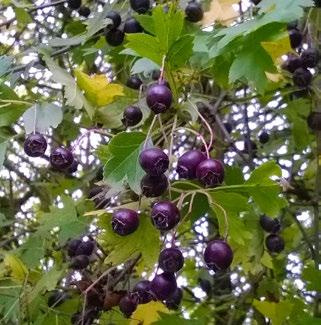
Crataegus pentagyna, Skelton Grange, Mid-West Yorkshire (v.c. 64). David Broughton
Cicerbita macrophylla (Willd.) Wallr. subsp. macrophylla (Common Blue Sow-thistle). Clapham (SD74556918), 20/4/2019, D. Broughton: growing with subsp. uralensis in a car park near public toilets. The latter subsp. (a native of Russia) has been known here since 2018, the rarer subsp. (from the Caucasus) being recognised in 2019 when a visit to the site coincided with its flowering. See alienplantsbelgium.

Cicerbita macrophylla subsp. macrophylla, Clapham, Mid-West Yorkshire (v.c. 64). David Broughton
be/content/cicerbita-macrophylla for a full treatment of the differences. David Broughton has also written a blog post about the discovery, botanyhuntsyorks. blogspot.com/2019/07/cicerbita-at-clapham.html. Has it been overlooked elsewhere, with or without subsp. uralensis? See Adventives & Aliens News 6, v.c.14.
V.c.67 (S. Northumb)
Euphorbia stricta (Upright Spurge). Hexham (NY939633), 8/10/2020, A.J. Richards: three large plants self-sown onto steep gravel path in housing estate. It is a rare native annual as well as garden plant. The third v.c. record. Stace (2019): 360.
V.c.68 (N. Northumb)
Euphorbia stricta (Upright Spurge). Howick (NU249176), 8/7/2020, A.J. Richards: by southern pair of picnic tables on east side of car park, Howick Gardens. Professor Richards commented that it is not grown in the gardens, so probably came in with a visitor. The first v.c. record.
V.c.87 (W. Perth)
Ventenata dubia (Leers) Coss. & Durieu (Wiregrass). Dunblane (NN778016), 20/6/2019, E. Lavery & J.R. Jones (det. T.A. Cope): in tall grass on north bank and within 3m of the Allan Water, Laighills Park. In his adjudication Dr Cope underscored the distinctive ribbed glumes and dimorphic florets, the lower of which is persistent. An annual grass found as a native in central Europe, the Mediterranean, southern Russia and south-west Asia. There appear to be only two other British records, for v.cc.63 (1972) and 18 (1986). In both cases it is believed to have been introduced with grass seed. BSBI News 45 p. 1 and pp. 24–25. Ryves et al (1996), fig. 16.
V.c.106 (E. Ross)
Trifolium incarnatum subsp. incarnatum (Crimson Clover). Hilton area (NH862773), 27/5/2020, T.D. Easter: c. 20 plants in field margin and on southfacing hedge bank, Clashnamuiach, very near the Dornoch Firth. Adventives & Aliens News 21, v.c.12.
V.c.H21 (Co Dublin)
Senecio minimus (Toothed Fireweed). Sandyford (O1976726493), 15/11/2020, A. Fitzgerald: scattered plants on concrete paving and in open area of a grassy verge near fencing, waste ground just north of Burton Hall Avenue. A new hectad record for the v.c. An annual and short-lived perennial composite, native to New Zealand, a wool casual and nursery weed. Alexis Fitzgerald commented that it seems to be in the process of spreading in the east/south-east of Ireland, with another recent record from v.c.H6, probably competing for similar niches to those of alien Erigeron (Fleabane) species. He further speculates if a 2019 v.c.49 record on the Llyn Peninsula, might have resulted from longdistance wind dispersal from eastern Ireland. BSBI News 97, p.49 (photocopied image of voucher specimen from Tresco, v.c.1b). BSBI News 137, pp. 58–59; BSBI News 141, pp. 52–54. Stace (2019): 804.
References
Clement, E.J. & Foster, M.C. 1994. Alien Plants of the British
Isles. Botanical Society of the British Isles, London. Clement, E.J., Smith, D.P.J. & Thirlwell, I.R. 2005. Illustrations of Alien Plants of the British Isles. Botanical Society of the
British Isles, London. Poland, J. & Clement, E.J. 2020. The Vegetative Key to the British
Flora (2nd edn). John Poland, Southampton. Ryves, T.B., Clement, E.J. & Foster, M.C. 1996. Alien grasses of the British Isles. Botanical Society of the British Isles,
London. Stace, C.A. 2019. New Flora of the British Isles (4th edn).
C & M Floristics, Middlewood Green, Suffolk.









